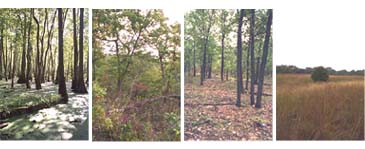
 |
| Left to Right: Tupelo Swamp, Barrens, Flatwoods, and Savanna |
Why are there different forest types?
Not all forests are alike. In any geographic region, environmental and other factors partially determine what sort of plants will be present. Plants that can survive drought or fire, for example, will occur together in regions likely to experience drought and fire.
Local environmental factors determine which individual species can live in a place. They also determine which different species can live there together. We recognize and classify these communities as distinct associations of different species within the broader region.
For example, the broad-leaf, deciduous forest includes communities such as sand forests in Illinois that are dominated by scrubby oaks (black oak, blackjack oak) and black hickory, and the mesic upland forests are dominated by sugar maple.
How
Forests are classified
Classification of forests is important for three reasons:
Classification
- defines the communities we are trying to preserve.
- increases our understanding of them through space (the state) and time (from ancient times throught today).
- allows us to describe these communities clearly so that we can communicate our ideas about them.
- geography (e.g., southeastern forest, Great Lakes forest),
- climate (e.g., tropical, boreal),
- dominant vegetation (e.g., oak-hickory forest)
- gross appearance (physiognomy)
- species composition (combination of species living together)
|
|
Copyright © 2000 Illinois State Museum